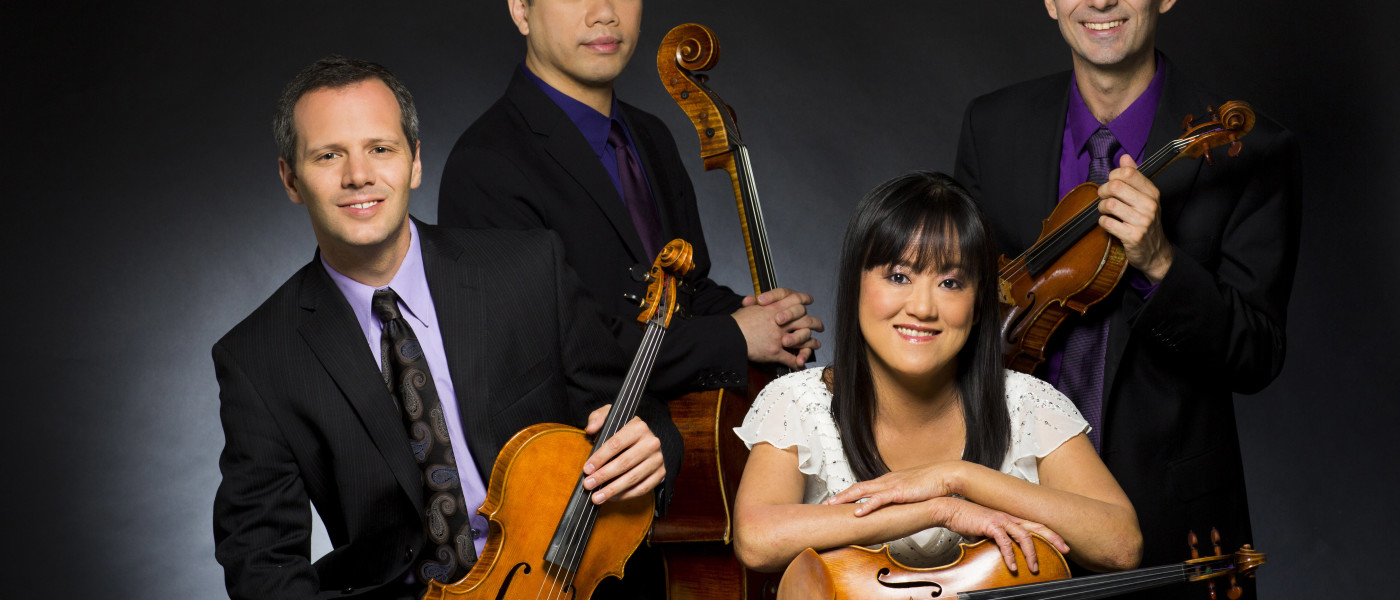Avalon String Quartet in Review
Northern Illinois University presents the Avalon String Quartet
Blaise Magnière, violin; Marie Wang, violin; Anthony Devroye, viola; Cheng-Hou Lee, cello
Weill Hall at Carnegie Hall, New York, NY
December 9, 2015
On December 9, 2015, Northern Illinois University presented the Avalon String Quartet at Weill Hall at Carnegie Hall in a program of works by Benjamin Britten, Mieczyslaw Weinberg, and Beethoven’s Op. 130, with the original Große Fuge finale. It was to prove to be a richly rewarding experience.
The Avalon’s members are Blaise Magnière (violin), Marie Wang (violin), Anthony Devroye (viola), and Cheng-Hou Lee (cello). They took to the stage and opened the concert with Three Divertimenti (a work originally intended to be a five-movement work based on a line from Shakespeare’s The Winter’s Tale) from Benjamin Britten (1913-1976). The work is without opus number, and the program notes state that after a poorly received performance, Britten shelved the work, and it was not performed again in his lifetime. Only the Burlesque is up the standards of Britten’s mature work, the March and Waltz being the products of a talented, but still developing, composer. This is not to disparage the attentive and lively reading from the Avalon – one can even commend them for bringing this work from one the giants of the 20th century to the public – but this work is really more of the curiosity sort.
The String Quartet No. 6 in E minor, Op. 35 (1946), from Polish-born Soviet composer Mieczyslaw Weinberg (1919-1996), followed the Britten. The program notes describe the work as “experimental in form,” having “moments of craziness” and state this work was never performed in Weinberg’s lifetime (it was premiered in 2007). How “experimental” and “crazy” it actually is is a matter of opinion (one that I disagree with on both counts), but one can make the case that the artistic environment in the Soviet Union at the time (particularly the infamous Zhdanov decree in 1948) made anything “experimental” extremely dangerous to the “offending composer.” Add to this Weinberg’s personal situation, being under scrutiny of the authorities (he was the son-in-law of Solomon Mikhoels, who was murdered in 1948 on Stalin’s orders), and later arrested in the “Doctors’ Plot,” Stalin’s last purge before his death. After the danger had passed, Weinberg had probably moved on (he was an extremely prolific composer) and the quartet forgotten. This six movement work clocks in at about thirty minutes, and proved to be a real revelation. It is a work that shows complete mastery of form, is filled with excitement, has interesting harmonic language and poignant melodies, and tests the technical abilities of the players to the maximum. I enjoyed it from start to finish, and I believe the Avalon has the opportunity to set the performance standard for this fine work. If tonight’s performance was any indication, the bar has been set very high. It ended the half in great style.
What immediately made a favorable impression to this listener (and viewer!), was the lack of excessive movement of the players as they played. I have written in the past how much I dislike the sight of watching four people writhing about on stage like fish out of water, and how such histrionics detract from my enjoyment of the music. The players have a certain rapport and no one player outshines the other- a true ensemble. The Avalon is all about the music- their passion comes through in the sound, as it should be!
After the intermission, it was time for the centerpiece of the night, Beethoven’s String Quartet No. 13 in B-flat major, Op. 130, with the Große Fuge, Op. 133. The program notes give an excellent music analysis, one that musicians would appreciate in its detail, but there was nothing to say about why Beethoven wrote an alternate finale and published the Große Fuge as a separate work, other than “upon reconsideration,” which suggested Beethoven was unhappy his original finale. Nothing could be further from the truth! Why Beethoven agreed to his publisher’s request for an alternate finale will never be known for certain, but the most plausible theory was for the need for money (which for Beethoven was always in short supply).
What continues to be remarkable about this work is that it sounds much more “modern” than many works written more than a hundred years later, a testament to Beethoven’s visionary genius. The six movements have no readily discernible commonality, but it nonetheless all “works”. The question was to how the Avalon would handle one of the most famous works in the repertoire, with a rich performance history from some of the most notable string quartets throughout the ages. The answer was “very well indeed!” The first four movements were excellent, but the fifth movement, the Cavatina, was especially moving in the hands of these wonderful players. The Avalon saved their very best for last. The Große Fuge was played with a ferocious intensity, but without the stridency that often mars so many performances. The Avalon was in complete command, confident and assured, as they negotiated the demands of this tour de force with an apparent ease that belied the extreme difficulty. It would stand up to comparison to any other ensemble. The audience gave the players a prolonged standing ovation.
The Avalon String Quartet is a fine ensemble, and one that all true lovers of chamber music should hear. I do hope to hear them again.

